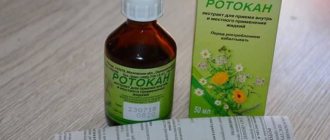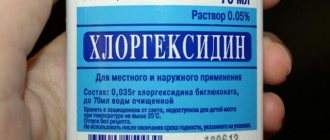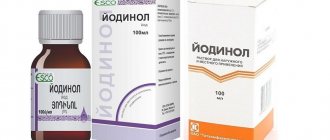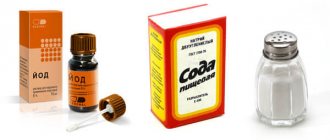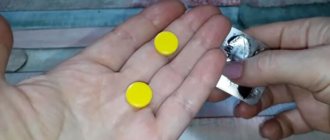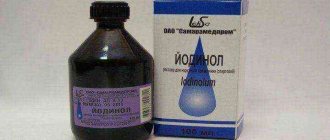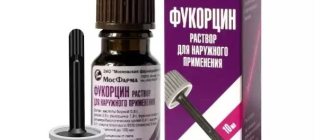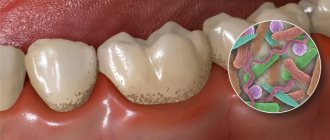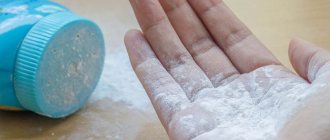Iodinol: what helps
The iodine contained in the product provides the solution with a bactericidal effect. The simultaneous presence of 95% ethanol enhances this effect. The product is intended exclusively for topical use on affected surfaces. It is recommended to treat the edges of the wound, excluding liquid from entering exposed tissue areas. Contacting a healthy surface, Iodinol triggers blood flow activation processes, since it also has a certain irritating effect.
A small part of the substance can be absorbed into the bloodstream from the surface of the skin through small capillaries. With the bloodstream, iodine is able to travel from organ to organ. Some of it will be absorbed by the thyroid gland during such a journey. Excretion from the body occurs through the kidneys, liver and intestines.
Iodinol is used for:
- small abrasions;
- injuries;
- myalgia;
- infectious lesions of the skin.
Apply a thin layer to the skin, not generously, using a cotton swab or cotton swab. It should be remembered that the product has a brown tint, which will remain as pigmentation on the body.
Useful properties and uses of blue iodine
Iodine preparations are used to treat the throat (Lugol's solution), to disinfect the skin around the injury (5% alcohol solution). The irritating and toxic substances they contain limit their oral use.
“Blue iodine” eliminates inflammation and treats various diseases of internal organs.
St. Petersburg scientist Mokhnach V.O. To neutralize the toxic effect of iodine, he combined it with starch. Blue potato jelly gave the drug its name – “blue iodine”.
Studies have confirmed the anti-inflammatory, antiseptic, antimicrobial, antiviral, antifungal properties of iodinol and any other colored iodine compounds, and their low toxicity.
The drug has a gentle effect on the microflora of the gastrointestinal tract, covers damage to the mucous membrane, creates a protective layer, which contributes to a speedy recovery.
Iodinol was first used during the Great Patriotic War for the treatment of bacterial dysentery, colitis, and enterocolitis. Tests have confirmed that oral administration clears bacteria from the intestinal mucosa within five days.
The antiviral and antibacterial properties of iodinol are used for various diseases. They are used to gargle, treat tonsillitis, colitis and enterocolitis, stomach ulcers, dysentery, bloody diarrhea, poisoning, stomatitis, conjunctivitis, non-healing wounds, burns.
The drug affects blood composition, protein and fat (lipid) metabolism, reduces cholesterol and glucose levels in the blood, cleans blood vessels, and restores their elasticity. Therefore, iodinol is not only used to gargle, but is used for recovery after a stroke and normalization of high or low blood pressure.
Ingestion enhances thyroid function. Its violation affects metabolism and reduces immunity.
- The best 8 drugs and 19 folk recipes for gargling with sore throat
Iodine preparations stimulate the reflex secretion of mucus in the respiratory tract and have an expectorant and sputum-thinning effect.
Iodinol for rinsing
In their practice, otolaryngologists often use Iodinol as a rinse. You just need to keep in mind that rinsing is not carried out with a pure solution, but with a prepared mixture of several drops. This procedure ensures the treatment of the tonsils. For chronic tonsillitis of any etiology, such rinsing allows you to relieve the severity of inflammation and wash off the pathogen from the surface of the porous tissue, disinfecting the surface of the tonsils for a while.
Additionally, iodine heating procedures may be prescribed. They involve applying the solution directly to the tonsils. Iodine, irritating the surface of the glands, activates blood flow in the capillaries and vessels, due to which the local temperature rises. Harmful microorganisms cannot multiply in such an environment, which contributes to a speedy recovery.
In addition to treating tonsils, Iodinol can be used as a component for preparing a solution for rinsing the nose. This product is also used to disinfect the walls of the respiratory tract and wash away most of the germs from them.
Iodinol: instructions for use
Iodinol is not taken orally. This product is for local external use only. It is necessary to follow the rules for treating wounds:
- Apply the product only to the edges of the wound.
- Avoid getting the solution on areas of the body that are bare of skin, as well as inside cuts and deep wounds.
- When preparing a solution for rinsing the nasopharynx, it is important to adhere to the concentration of the substance recommended by the doctor.
- Home application of Iodinol on the tonsils should be limited to three times a day.
Exceeding dosages will certainly lead to burns. If the doctor recommended preparing a solution for rinsing the nose from 10 drops of Iodinol and a glass of water, this means that every extra drop can cause the nasal mucosa to lose its ability to moisturize and warm the inhaled air. Crusts, inflammations and ulcers will form.
Applying iodine to an open wound will aggravate the situation and may provoke a painful shock, since in addition to iodine molecules, the solution contains 95% alcohol. It will be an additional source of chemical burns. In places where the skin is already damaged and nerve endings are exposed, the ingress of such an aggressive solution will only aggravate the patient’s condition.
How to gargle
Before using a product such as Iodinol for gargling, the instructions should be carefully studied. Contraindications, proportions for diluting the product and precautions should be taken into account. If you are using Iodinol for the first time and find signs of individual intolerance or hypersensitivity to the components, then you need to stop treatment with this remedy and gargle with a regular soda-saline solution.
Signs of hypersensitivity
- Skin itching
- Rash,
- Runny nose,
- Salivation,
- Tearing.
Also very important when rinsing with Iodinol is the dosage and proportions of dilution of the product. If the solution is too concentrated, then not only the mucous membrane of the throat, but the gastrointestinal tract and kidneys may be damaged.
How to dilute Iodinol for gargling? The drug is added to boiled warm water in the amount of about one tablespoon, but this must be done slowly, drop by drop. This will allow you to obtain a solution of the desired concentration. With a procedure such as gargling with Iodinol, the proportions are determined quite simply: by the color of the finished liquid. A safe solution of Iodinol has a dark yellow color, that is, as soon as the liquid in the glass has turned intense yellow, it is ready for gargling.
It is usually recommended to gargle after eating so that the drug remains on the mucous membranes longer. Before the procedure, you should first rinse your throat and mouth with clean warm water.
The frequency of rinsing depends on the stage of the disease. If this is just the beginning, then three to four procedures a day are enough. If the process is already in an advanced state, then you need to rinse with Iodinol every 4 hours, and in between, you should rinse with saline or soda-saline solution. If you have chronic tonsillitis, then at the very beginning of an exacerbation it is enough to gargle once a day. In case of intense purulent formations, rinsing alone will not be enough; you need to lubricate the tonsils with Iodinol solution. To do this, a cotton swab is dipped into a slightly diluted preparation, after which the tonsils are treated.
The course of treatment with rinsing with Iodinol is 5 days. A noticeable positive effect will be seen within 2 days, but do not stop rinsing. Doctors also do not recommend continuing treatment with Iodinol for longer than 5 days. If the results of treatment during this time are unsatisfactory, then more radical methods must be used.
Contraindications
The use of Iodinol is contraindicated for persons with individual iodine intolerance. It is also worth considering the susceptibility of the thyroid gland to iodine molecules. She needs it, and a deficiency of iodine molecules can lead to dysfunction of the organ that produces hormones. But it is important to remember that excess iodine is not beneficial, since it will also affect hormonal levels and the health of the thyroid gland.
Pregnant women should refrain from using any medications, even topically, without consulting a doctor, including Iodinol. If there is an inflammatory process in the tonsils, nasal passages and ears, you should not self-medicate, but immediately consult your local doctor.
Iodinol: price
The product is sold in glass bottles of 50 ml or 100 ml. Some manufacturers have equipped their bottles with spray nozzles. It is worth keeping in mind that the presence of such a sprayer does not mean that the product is ready for application to the oral cavity or nasal mucous membranes. The nozzle makes it easier to treat the skin area around the wound. Only the presence of a separate footnote in the instructions attached to the bottle can indicate the concentration of the active substance and the permissible use of the solution unchanged for rinsing.
You can buy a 50 ml bottle without a spray nozzle for 30 rubles. Depending on the name of the manufacturer, the price may vary. The presence of a spray bottle affects pricing. With it, a bottle of the same volume will cost from 100 rubles.
Treatment of acute and chronic pharyngitis
F
Aringitis is an acute or chronic inflammation of the pharyngeal mucosa, which is accompanied by pain, soreness or discomfort in the throat. Since, from an anatomical point of view, the pharynx is divided into three sections - upper (nasopharynx), middle (oropharynx) and lower (hypopharynx), inflammatory processes developing here can also be divided according to their predominant localization. However, this division will be very conditional, especially in acute pharyngitis, due to the fact that acute viral and bacterial infections diffusely affect the mucous membrane of the upper respiratory tract and are migrating, often descending in nature. Morphological changes in the mucous membrane in chronic pharyngitis usually have a predominant localization in one of the anatomical parts of the pharynx, which makes it possible to tentatively identify individual nosologies, for example, chronic nasopharyngitis.
Etiology and classification
According to the etiological factor, acute pharyngitis can be divided into viral, bacterial, fungal, allergic, traumatic (as a result of a foreign body or surgical intervention) and caused by exposure to irritating factors (hot liquid or steam, acids, alkalis, radiation, etc.). Chronic pharyngitis is usually classified not according to etiology, but according to the nature of the changes developing in the mucous membrane: catarrhal (simple), atrophic (subatrophic) and hypertrophic. These forms of chronic inflammation are often combined. Thus, the presence of diffuse atrophic changes in the mucous membrane can be combined with focal hyperplasia of the lymphoid tissue of the posterior pharyngeal wall or tubopharyngeal ridges.
| Classification of pharyngitis Spicy
Chronic
|
The most common form of acute inflammation of the pharyngeal mucosa is catarrhal pharyngitis during ARVI. It is known that approximately 70% of pharyngitis is caused by viruses, including rhinoviruses, coronaviruses, respiratory syncytial virus, adenovirus, influenza and parainfluenza viruses. The most common causative agent of acute pharyngitis is rhinoviruses. Research in recent years shows that their importance is growing rapidly, and now rhinoviruses are responsible for more than 80% of acute respiratory viral infections during autumn epidemics. Viral infection is often only the first phase of the disease, and it “paves the way” for subsequent bacterial infection. In Fig. 1 and below provide information about the main pathogens of acute pharyngitis.
Rice.
1. Bacteria and fungi - the causative agents of acute pharyngitis (according to CA Dagnelie, 1994) Viruses - the causative agents of acute pharyngitis
(in descending order of frequency):
Basic:
- Rhinoviruses
- Coronaviruses
- Adenoviruses
- Influenza virus
- Parainfluenza virus
Rare:
- Respiratory syncytial virus
- Herpes simplex viruses (types 1 and 2)
- Enteroviruses
- Coxsackie virus
- Epstein–Barr virus
- Cytomegalovirus
- AIDS virus
These generalized data, taken from foreign manuals on otorhinolaryngology and infectious diseases, are very conditional, since the concept of “sore throat”, used in English (the Russian-language analogue is acute pharyngitis or pharyngotonsillitis), is not a definition of a specific nosological form, but rather a collective term for several diseases [3–6,10]. In addition to the nonspecific form, there are other types of pharyngitis associated with specific pathogens, for example, Epstein-Barr virus in infectious mononucleosis, Yersinia enterocolitica
for yersenial and gonococcus for gonorrheal pharyngitis, as well as
Leptotrix buccalis
for leptotrichosis of the pharynx.
Clinic and diagnostics
For the clinical picture of acute pharyngitis
Characterized by soreness, dryness, discomfort and pain in the throat when swallowing (especially with an empty throat), less often - general malaise, a rise in temperature. When the tubopharyngeal ridges become inflamed, the pain usually radiates to the ears. On palpation, there may be pain and enlargement of the upper cervical lymph nodes. Pharyngoscopy reveals hyperemia of the posterior wall of the pharynx and palatine arches, individual inflamed lymphoid granules, but there are no signs of inflammation of the tonsils characteristic of angina. It should be remembered that acute pharyngitis may be the first manifestation of some infectious diseases: measles, scarlet fever, rubella measles. In some cases, differential diagnosis with Kawasaki disease and Stevens-Johnson syndrome is required.
For the clinical picture of chronic pharyngitis
An increase in temperature and a significant deterioration in general condition are not typical. The sensations are characterized by patients as dryness, soreness and a feeling of a lump in the throat, which causes a desire to cough or “clear the throat”. The cough is usually persistent, dry and easily distinguishable from the cough that accompanies the course of tracheobronchitis. Discomfort in the throat is often associated with the forced need to constantly swallow mucus in the back of the throat, which makes patients irritable, interferes with their normal activities and disrupts sleep.
With atrophic pharyngitis, the mucous membrane of the pharynx looks thinned, dry, and often covered with dried mucus. Injected vessels may be visible on the shiny surface of the mucous membrane. In the hypertrophic form, pharyngoscopy reveals foci of hyperplastic lymphoid tissue randomly scattered on the posterior wall of the pharynx or enlarged tubopharyngeal ridges located behind the posterior palatine arches. At the time of exacerbation, these changes are accompanied by hyperemia and swelling of the mucous membrane, but usually the paucity of objective findings does not correspond to the severity of the symptoms that bother patients.
Chronic pharyngitis is often not an independent disease, but a manifestation of the pathology of the entire gastrointestinal tract: chronic atrophic gastritis, cholecystitis, pancreatitis. The entry of acidic gastric contents into the pharynx during sleep with gastroesophageal reflux disease and hiatal hernia is often a hidden cause of the development of chronic catarrhal pharyngitis, and in this case, without eliminating the underlying cause of the disease, any local treatment methods provide an insufficient and short-lived effect. Smoking and tonsillectomy lead to the development of atrophic changes in the pharyngeal mucosa.
Pharyngitis often develops with constantly difficult nasal breathing. It can be caused not only by switching to mouth breathing, but also by the abuse of vasoconstrictor drops, which flow from the nasal cavity into the pharynx and have an unnecessary anemic effect there. Symptoms of pharyngitis may be present with the so-called postnasal drip (postnasal drip). In this case, discomfort in the throat is associated with the flow of pathological secretions from the nasal cavity or paranasal sinuses along the back wall of the pharynx. In addition to constant coughing, this condition can cause wheezing in children, which requires differential diagnosis with bronchial asthma.
The main factors contributing to the development of chronic pharyngitis:
- constitutional features of the structure of the mucous membrane of the pharynx and the entire gastrointestinal tract;
- prolonged exposure to exogenous factors (dust, hot dry or smoky air, chemicals);
- difficulty breathing through the nose (breathing through the mouth, abuse of decongestants);
- smoking and alcohol abuse;
- allergy;
- endocrine disorders (menopause, hypothyroidism, etc.);
- vitamin deficiency A;
- diabetes mellitus, heart, pulmonary and kidney failure.
For persistent sore throat that cannot be treated with conventional therapy, differential diagnosis is required with a number of syndromes that develop in certain systemic diseases and diseases of the nervous system. Plummer–Vinson syndrome occurs in women aged 40 to 70 years against the background of iron deficiency anemia. Sjogren's syndrome is an autoimmune disease, accompanied, in addition to severe dryness of the mucous membrane of the gastrointestinal tract, by diffuse enlargement of the salivary glands. Eagle syndrome (stilalgia) is characterized by severe, persistent, often unilateral pain in the throat caused by elongation of the styloid process, which is located on the lower surface of the temporal bone and can be palpated above the upper pole of the tonsil. A number of neuralgias (glossopharyngeal or vagus nerve) can also cause sore throat, especially in older people.
Treatment
In case of acute and exacerbation of chronic pharyngitis, not accompanied by pronounced disorders of the general condition, symptomatic treatment is sufficient, including a gentle diet, hot foot baths, warm compresses on the front surface of the neck, milk with honey, steam inhalations and gargling. Smoking should be stopped. Uncomplicated pharyngitis usually does not require systemic antibiotics. In this situation, it becomes justified to carry out not systemic, but local antimicrobial therapy, which can also be prescribed in the form of monotherapy. However, a survey conducted in Belgium showed that in general, 36% of doctors resort to prescribing antibiotics for acute respiratory viral infections and pharyngitis [7]. This article will discuss drugs for the local treatment of acute and chronic pharyngitis.
The main drugs for local antimicrobial therapy presented on the Russian market are listed in Table. 1. These drugs usually contain one or more antiseptics (chlorhexidine, hexetidine, benzydamine, ambazone, thymol and its derivatives, alcohols, iodine preparations, etc.), essential oils, local anesthetics (lidocaine, tetracaine, menthol), less often – antibiotics (fusafunzhin, framycetin) or sulfonamides, deodorizing agents. Preparations may also contain bacterial lysates (Imudon), natural antiseptics (plant extracts, bee products), synthesized factors of nonspecific protection of mucous membranes, which also have an antiviral effect (lysozyme, interferon), vitamins (ascorbic acid).
Antimicrobial drugs can be prescribed in the form of rinses, insufflations, inhalations, as well as tablets and lozenges. The main requirements for drugs applied to the mucous membrane are:
- a wide spectrum of antimicrobial action, preferably including antiviral and antimicrobial activity;
- lack of toxic effect and low rate of absorption from mucous membranes;
- low allergenicity;
- no irritating effect on the mucous membrane.
Most of those listed in table. 1 drugs (Hexalize, Drill, Septolete, Faringosept, Neo-angin, Strepsils, etc.) are available in the form of tablets, lozenges or lozenges. This form of drugs has relatively low activity, and their use is limited to mild forms of the disease. In addition, the doctor should remember the toxicity of chlorhexidine, which is part of many drugs (Antiangin, Drill, Sebidine, Eludril) and should not allow their unlimited, uncontrolled use by patients (especially children).
The prescription of a number of drugs is limited by their high allergenicity and irritating effect. This includes drugs containing iodine derivatives (iodinol, iox, vocadine, povidone-iodine), propolis (proposol), sulfonamides (bicarmint, ingalipt). Preparations containing herbal antiseptics and essential oils are effective and harmless, but their use is contraindicated in patients suffering from allergies to pollen, and the number of people with this disease in some geographic areas is up to 20% of the population.
Due to the fact that within the framework of this article it is impossible to give a detailed overview of all the drugs listed in Table 5, we will focus only on those drugs that are regularly used in our practice and the effectiveness of which has been confirmed by our own experience.
Inhalation antibiotic fusafyungin (Bioparox)
– a drug that combines antibacterial properties with anti-inflammatory properties and is produced in the form of a dosed aerosol, has been used in the treatment of respiratory tract infections for more than 20 years. Due to the very small size of aerosol particles, fusafunzhin is able to penetrate into the most inaccessible parts of the respiratory tract and exert its therapeutic effect there. The high antimicrobial effectiveness of fusafyungin in acute pharyngitis, laryngitis and tracheobronchitis has been confirmed by a large number of observations. The spectrum of antimicrobial activity of fusafyungin is adapted to microorganisms that are most often the causative agents of upper respiratory tract infections; it is also active against mycoplasma infections. The unique quality of this drug is the stability of its spectrum of action: during its use, no new strains of bacteria resistant to it have emerged. In addition to antibacterial properties, fusafungin has its own anti-inflammatory effect, which has been demonstrated in experimental studies [8]. It enhances phagocytosis of macrophages and inhibits the formation of inflammatory mediators. This explains the effectiveness of the drug for viral pharyngitis, although the drug does not have a direct inhibitory effect on viruses. When prescribing fusafunzhin, a smoother course after tonsillectomy was noted [1].
Imudon
fundamentally different from all drugs used for local treatment of pharyngitis.
It is a multivalent antigenic complex, which includes lysates of 10 bacteria, as well as two causative agents of fungal infections (Candida albicans and Fusiformis fusiformis),
most often causing inflammatory processes in the oral cavity and pharynx. Imudon activates phagocytosis, helps increase the number of immunocompetent cells, increases the content of lysozyme and secretory IgA in saliva. Data have been obtained indicating that the administration of imudon for acute, as well as catarrhal, hypertrophic and subatrophic forms of chronic pharyngitis is more effective than traditional methods of treatment, such as inhalation of alkaline and antibacterial drugs, cauterization of granules with a solution of silver nitrate and the use of other anti-inflammatory and analgesic drugs [2]. If necessary, imudon combines well with local or systemic antibiotics, helping to reduce recovery time and maintain local immune defense, which is especially important during antibiotic therapy. Imudon is available in the form of lozenges.
Hexetidine
(Hexoral) is available both as a rinse solution and an aerosol. Unlike chlorhexidine, the drug is low-toxic. It is active against most bacteria - the causative agents of pharyngitis and tonsillitis, as well as fungi. In addition to being antimicrobial, hexetidine has a hemostatic and analgesic effect, which justifies its use not only after tonsillectomy and opening of a peritonsillar abscess, but also after extensive operations in the pharynx (for example, operations for obstructive sleep apnea syndrome, etc.). The combination of the above-mentioned effects with the deodorizing effect of the drug is beneficial in patients with tumors of the upper respiratory tract, in particular, those receiving radiation therapy.
Antiseptic for mucous membranes octenisept
has, perhaps, the widest spectrum of antimicrobial action, covering gram-positive and gram-negative bacteria, chlamydia, mycoplasma, fungi, protozoa, as well as herpes simplex viruses, hepatitis B and HIV. The effect of the drug begins within a minute and lasts for an hour. Octenisept has no toxic effect and is not absorbed through intact mucous membranes. We use a solution of octenisept, spraying this solution onto the mucous membranes using an insufflator [9]. Of course, the main disadvantage of this drug is that it is not available in forms convenient for independent use, and its use is mainly limited to the practice of specialized departments.
Local antibacterial agents can be widely used in the treatment of pharyngitis.
The choice of the optimal drug is determined by the spectrum of its antimicrobial activity, the absence of allergenicity and toxic effect. Of course, the most effective local drugs will not completely replace the need for systemic administration of antibiotics for sore throat and pharyngitis caused by beta-hemolytic streptococcus. On the other hand, due to the nonbacterial etiology of many forms of pharyngitis, the emergence of an increasing number of resistant strains of bacteria, as well as the undesirable effects of general antibiotic therapy, local administration of drugs with a broad spectrum of antimicrobial activity is in many cases the method of choice. Literature:
1. Luchikhin L.A., Buyanovskaya O.A., Derevyanko S.N., Paukova M.V. The effectiveness of Bioparox treatment of acute inflammatory diseases of the upper respiratory tract. Vestn. otorhinol., 1996; 2: 38–42.
2. Luchikhin L.A., Malchenko O.V. The effectiveness of the drug Imudon in the treatment of patients with acute and chronic inflammatory diseases of the pharynx // Vestn. otorhinol., 2001; 3:62–4.
3. Dagnelie CF Sore Throat in General Practice. A Diagnostic and Therapeutic Study. Thesis. Rotterdam, 1994.
4. Hansaker DH, Boone JL Etiology of Infectious Diseases of the Upper Respiratory Tract. In: Ballenger JJ, Snow JB, editors, Otorhinolaryngology: Head and Neck Surgery. 15th edition. Baltimore: Williams & Wilkins, 1996, 69–83.
5. Gwaltney JM The common cold. In: Mandell GL, Bennet JE, Dolin R, editors, Principles and Practice of Infectious Diseases. 4th Edition. NY: Churchill Livingstone - 1996, 561–6.
6. Gwaltney JM Pharyngitis. Ibid., 566–9.
7. de Melker R. Prescribing patterns for respiratory tract infections: Dutch data from international perspective. In: Program and abstracts of the 3rd International Meeting on Upper Respiratory Tract Infections. Crete, 1997, S1.
8. Otori N., Paydas G., Stierna P., Westrin KM The anti-inflammatory effect of fusafungine during experimentally induced rhinosinusitis in rabbit. Eur Arch Otorhinolaryngol 1998; 255:195–201.
9. Piskunov GZ, Piskunov SZ, Lopatin AS Substantiation of the use of Octenisept in acute and chronic inflammation of nasal mucosa. In: Liber Amicorum. Prof. Dr. EHHuizing 1976–1997. Utrecht, 1997; 181–5.
10. Rice DH Microbiology. In: Donald PJ, Gluckman JL, Rice DH, Editors, The Sinuses. New York: Raven Press, 1995, 57–64.
Combined drug -
Imudon (trade name)
(Solvay Pharma)
Combined drug -
Strepsils (trade name)
(Boots Healthcare International)
